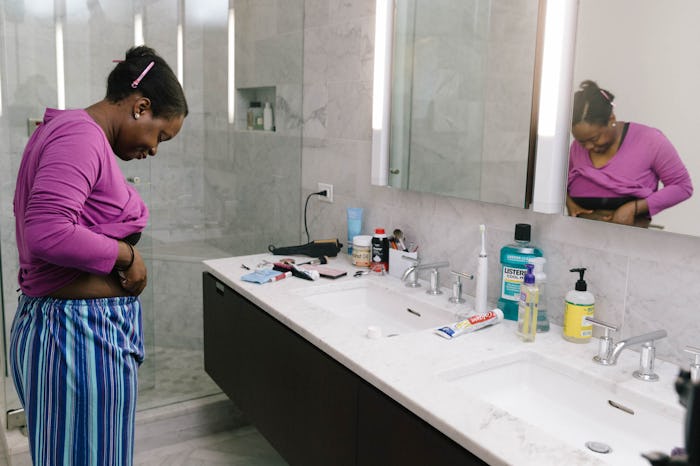No matter how much I read or what I was taught in my prenatal classes, I was in no way prepared for the kind of care my private parts would require after childbirth. Yes, I was aware that there would be blood and tenderness, and they may even need to cut me down there. But until you've gone through it, the gravity of the situation is difficult to grasp. Thank goodness for the caring nurses and midwives who are there to thoroughly explain how to take care of your vagina after giving birth.
With my first child, I could barely sit on the toilet after delivery. Everything felt swollen and sore, and I was afraid that it would hurt too much to pee. There was so much blood in the toilet when I finally sat down, that I was sure my episiotomy stitches had torn open. With a great amount of patience, my nurse showed me all of the supplies in the bathroom that were there to keep me clean and help me get some much needed relief during my recovery. She explained each item in detail, and soon I was beginning to feel like myself again.
Even though you, too, will probably have a great nurse or midwife to help you out after childbirth, you should check out this quick guide on taking care of your vagina after giving birth.
1Avoid Tampons
After childbirth, women experience vaginal bleeding known as lochia. This is similar to a menstrual period, but it occurs when the uterus sheds the cells and tissues that remain after childbirth. According to U.K.'s National Health Service, you can't use tampons immediately after childbirth and should wait until your health care provider gives you the OK to do so. You will still have a wound where the placenta joined with your uterine wall and inserting a tampon (or anything else in your vagina, including sex) can increase the risk of this wound developing an infection. Use sanitary pads during this time to give your body enough time to heal.
2Use An Ice Pack
If you have swelling or pain around the opening of your vagina, WebMD suggested putting ice or a cold pack on the area for 10 to 20 minutes at a time. Make sure to put a thin cloth between the ice and your skin. Ice packs are also good to help alleviate the pain caused by postpartum hemorrhoids. You can even find reusable cold packs designed especially for the vaginal area ($25).
3Cleanse With Water
Instead of wiping with toilet paper, What To Expect recommended cleaning your vaginal area by squirting warm water over it during and after urinating using a perineal irrigation bottle. Your hospital will likely provide a basic one for you, but there are peri bottles with curved spouts ($15) available that make postpartum vaginal washing much easier. When you are done washing, don't rub, but pat yourself dry with gauze pads or the paper wipes that come with your hospital-approved sanitary pads.
4Take A Sitz Bath
If you had a tear or an episiotomy during childbirth, the University of Pittsburgh Medical Center advised using a sitz baths to make you more comfortable and to help you heal. A sitz bath is a warm, shallow bath that cleanses and soothes the perineum (the area from the vagina to the anus). Your hospital will likely give you a one to take home, but a variety of sitz baths are also available at the drug store or online ($10).
First, fill the sitz bath with warm water. Next, lift the toilet seat, placing the bath under the seat and then put down the seat. Finally, sit with your bottom in the warm water until it no longer feels warm. Use the sitz bath for 10 to 15 minutes at a time, three times per day, for the first week after delivery. Remember to always use fresh water and gently pat yourself dry.
In a recent interview with Romper, Certified Nurse Midwife Simone Montoute warns against adding anything to the water, especially anything that smells sweet or antiseptic, as these can be too harsh for vaginal tissue.
5Use Witch Hazel Pads
There are premade witch hazel pads ($6) available, or you can even make your own. Witch hazel pads will not only alleviate your sore vaginal area, but they help with hemorrhoids, as well. The Bump recommended lining your maxi pad with witch hazel pads to get maximum relief.
6Manage Your Pain
One of my lifesavers after childbirth was the can of Dermoplast pain relieving spray ($6) I was given at the hospital. I was advised to spray it on my perineal area each time I used the restroom or showered. Your health care provider may also recommend a pain reliever such as ibuprofen to help alleviate perineal pain and postpartum cramping.
7Wait To Flush
Because flushing water may splash onto the perineum, Health Pages, suggested waiting until you've stood up and pulled up your pants to flush after using the toilet. This will help prevent infections, especially when using public restrooms.
8Continue To Take Prenatal Vitamins
Montoute says new moms should continue taking prenatal vitamins and maintain a balanced diet high in protein. Additionally, she says you should try to get as much rest as possible, avoiding any strenuous lifting or exercise until you have been given the go ahead by your health care provider.
9Know When To Seek Help
It's normal to feel discomfort after childbirth, but if the pain does not improve with time, Montoute recommends contacting your healthcare professional to make sure there isn't something else wrong. You should also seek help if you notice a bad odor coming from your vagina, have a temperature above 100.4 degrees F, or experience difficulty with urination.
